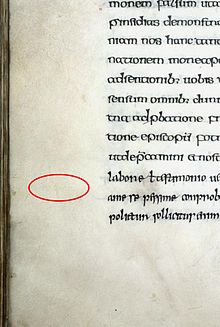Stylus glosses

As stylus glosses are comments referred to in early medieval manuscripts found at the edge or between the lines of the text and with the pen to parchment have been scratched. Unlike the feather glosses made with ink, they are only visible in sidelight .
In the monasteries, the valuable ink and quills were reserved for the scriptoria to create the writings. In his cell, the monk only had the wax or slate and the stylus at his disposal, so that he often notched or scratched his notes on the edge of the texts he was studying. These scratches were to a certain extent recognizable in the side light of the candle, but remained almost invisible in the diffuse daylight.
Stylus glosses, such as those found in the so-called Essen Carolingian Gospels , are among the traces of use that are becoming increasingly important for the more recent codicological research of the Middle Ages , comparable to the so-called parchment waste , which is also increasingly recognized, and its importance for the transmission of literature from the High Middle Ages . The traces of use also include the marginalia , which testify to the early European writing culture of the monasteries, among other things in the form of stylus glosses .
The incised words also provide information about the spoken language of their time, because their spelling sometimes deviates from the conventional writing of the sounds in manuscripts. They became valuable evidence of the development of Old High German and its sound change from the 8th to the 10th century. The change from the word gasti to guests can be traced, for example, using stylus glosses.
literature
- Rolf Bergmann , Stefanie Stricker: Catalog of the Old High German and Old Saxon gloss manuscripts . Walter de Gruyter, Berlin / New York 2005, ISBN 3-11-018272-6 .
- Rolf Bergmann, Stefanie Stricker (Ed.): The Old High German and Old Saxon Glossography. A manual. 2 vols. Berlin / New York 2009, ISBN 978-3-11-021697-4 .
Web links
- To the Old High German Glossy Wiki of the University of Augsburg with a current list of all manuscripts with ahd. And as. Stylus glosses
- To the project of a database of Old High German stylus glosses at the University of Augsburg
- On the techniques and practices of medieval continental Germanic writing
- How the Germans learned to write . (PDF; 2.0 MB) In: Unimagazin. The Journal of the University of Zurich , Volume 15, No. 1, January 2006, pp. 8–11.
Individual evidence
- ↑ See information on the catalog: Cologne, Cathedral Library, Codex 213
- ↑ According to How the Germans learned to write . ( Memento from February 21, 2014 in the Internet Archive ) (PDF; 2.0 MB) In: Unimagazin. The magazine of the University of Zurich . 15. Vol. 1, January 2006, p. 10.